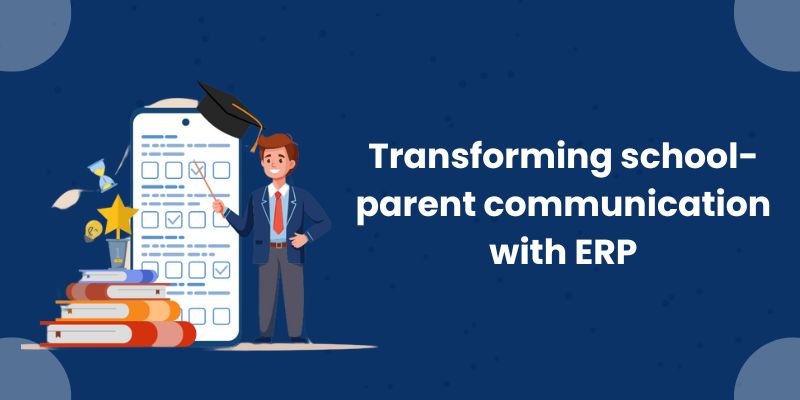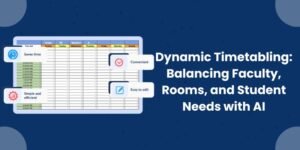For decades, school-parent communication relied on student diaries, printed circulars, and parent-teacher meetings (PTMs). While these traditional channels once served their purpose, they now fall short in a world that demands instant, reliable, and clear information. Memos can get lost in backpacks. Messages on WhatsApp can be missed in a flood of texts. PTMs, often held once a term, can feel too little, too late.
In today’s digitally connected world, parents expect more — more transparency, more access, and more involvement in their children’s education. And schools, too, are looking for smarter, more efficient ways to engage with families without overburdening teachers and staff.
Enter ERP systems — once associated only with corporate and industrial operations, now revolutionizing the education sector. A school ERP isn’t just about managing administrative workflows — it’s about transforming how schools connect, communicate, and collaborate with the families they serve.
Let’s explore how ERP platforms are reshaping school-parent communication and creating more responsive, informed, and empowered school communities.
1. Centralized Communication: One Platform, All Updates
One of the biggest pain points in school communication is fragmentation. Schools often juggle multiple channels: WhatsApp groups, SMS alerts, printed notices, teacher calls, and school apps — leading to confusion, duplication, and inconsistent messaging.
A robust ERP system simplifies everything by consolidating all communications into a single, secure platform. Parents simply log in to an app or portal and get instant access to:
- Daily attendance
- Homework and assignments
- Exam timetables and marks
- Class notes and circulars
- School announcements and news
- Transport updates
- Event invitations
This centralization eliminates the risk of missed messages and ensures every parent has equal access to accurate and timely information — no matter where they are.
2. Real-Time Notifications and Alerts
One of the most powerful features of a school ERP system is the ability to send real-time push notifications.
Imagine a parent getting an immediate alert the moment their child is marked absent. Or a fee reminder popping up a week before the due date. Or an urgent announcement — like a rain day or an early dismissal — reaching every parent in seconds.
With real-time notifications, schools can shift from reactive to proactive communication, creating a sense of responsiveness and reliability that parents deeply appreciate. It also reduces dependency on outdated or manual methods, which can delay important messages.
3. Improved Academic Engagement
ERP platforms help close the information gap between home and school when it comes to academic performance. Rather than waiting for quarterly report cards or PTMs, parents can now track their child’s progress continuously through interactive dashboards.
These dashboards include:
- Grade breakdowns by subject and term
- Attendance records and punctuality stats
- Behavioral notes and disciplinary flags
- Teacher comments and feedback
- Participation in extracurriculars or school clubs
This real-time visibility allows parents to step in and support their child early — whether it’s offering help with a subject, reinforcing discipline, or celebrating achievements.
4. Two-Way Communication Channels
In traditional systems, communication is often one-sided — schools inform, parents listen. But today’s parents expect a dialogue, not a monologue.
ERP platforms allow for two-way communication through:
- Message boards and teacher chat modules
- Parent-teacher meeting scheduling
- Feedback forms and surveys
- Digital acknowledgments and comments
This encourages collaborative problem-solving, improves teacher-parent rapport, and ensures no parent feels left out of the loop.
5. Automated Fee Management and Receipts
One of the most stressful aspects of school administration is managing tuition and fees. With ERP, schools can:
- Set up digital invoices and payment portals
- Send automated reminders before due dates
- Offer secure, online payment options (UPI, credit/debit card, net banking)
- Generate instant receipts and transaction history
- Handle concessions and late fees transparently
For parents, this removes the inconvenience of standing in queues or tracking paper receipts. For schools, it ensures better financial planning, less manual work, and fewer delays in collections.
6. Security and Data Protection
Unlike informal communication tools like WhatsApp or email, ERP systems are built for safety. With features like encrypted messaging, OTP logins, and role-based access controls, ERP platforms protect sensitive student data and ensure only the right people see the right information.
Additionally, all communication is logged and time-stamped, which is particularly useful for audits, conflict resolution, and long-term records.
This gives parents peace of mind that their children’s information is handled responsibly and professionally.
7. Personalized Parent Experience
ERP systems also allow for personalization, which is crucial in a multicultural, multilingual educational landscape. Parents can:
- Choose preferred languages for communication
- Set notification preferences
- Customize dashboards to focus on the most relevant information (e.g., homework alerts, bus tracking, or academic reports)
This flexibility enhances inclusivity, especially in diverse communities, and shows that the school cares about meeting parents where they are.
8. Reduced Administrative Burden
With traditional methods, school staff spend a considerable amount of time printing circulars, manually updating registers, answering repetitive queries, or collecting payments.
ERP automates much of this workload. One click can:
- Send notices to all classes
- Generate real-time attendance sheets
- Pull academic reports for review
- Notify about pending fees
- Schedule meetings across staff calendars
As a result, teachers can focus more on teaching, and admins can manage more effectively — without being buried in paperwork.
9. Better Attendance and Event Participation
Automated attendance alerts not only keep parents informed, but also improve student attendance. Parents become instantly aware of any absence and can act quickly to resolve issues like illness, transportation delays, or disengagement.
For school events — whether cultural fests, PTMs, or sports day — ERP platforms help boost participation by:
- Sending digital invites and reminders
- Allowing RSVP and feedback collection
- Sharing schedules, parking instructions, and post-event galleries
This level of organization builds excitement, improves turnout, and strengthens community bonding.
10. A More Professional, Modern School Image
In today’s competitive educational landscape, how a school communicates is a reflection of its values. An ERP-driven approach signals that a school is:
- Technologically progressive
- Transparent in operations
- Serious about parent engagement
- Focused on long-term efficiency
Parents perceive ERP-enabled schools as better equipped to meet modern challenges — and often recommend them to others.
Technology That Builds Trust
At the heart of every successful educational journey lies a strong partnership between school and home. ERP systems don’t aim to replace human connection — they enhance it. By offering clarity, consistency, and convenience, ERP makes school-parent communication more meaningful, not mechanical.As more schools embrace this digital transformation, the result is more than just operational efficiency. It’s trust, collaboration, and a better learning environment for every child.












